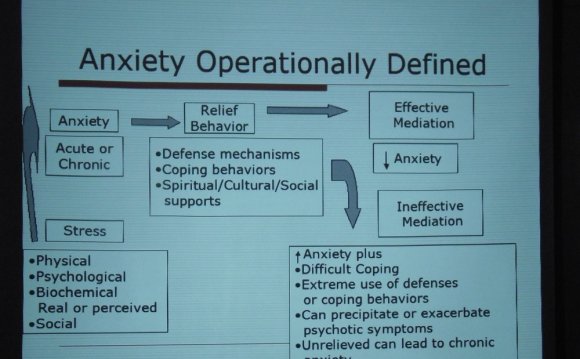
Medication and specific types of psychotherapy are the recommended treatments for this disorder. The choice of one or the other, or both, depends on the patient's and the doctor's preference, and also on the particular anxiety disorder.
Before treatment can begin, the doctor must conduct a careful diagnostic evaluation to determine whether your symptoms are due to an anxiety disorder, which anxiety disorder(s) you may have, and what coexisting conditions may be present. Anxiety disorders are not all treated the same, and it is important to determine the specific problem before embarking on a course of treatment. Sometimes alcoholism or some other coexisting condition will have such an impact that it is necessary to treat it at the same time or before treating the anxiety disorder.
If you have been treated previously for an anxiety disorder, be prepared to tell the doctor what treatment you tried. If it was a medication, what was the dosage, was it gradually increased and how long did you take it? If you had psychotherapy, what kind was it, and how often did you attend sessions? Oftentimes people believe they have "failed" at treatment, or that the treatment has failed them, when in fact it was never given an adequate trial.
When you undergo treatment for an anxiety disorder, you and your doctor or therapist will be working together as a team. Together, you will attempt to find the approach that is best for you. If one treatment doesn't work, the odds are good that another one will. And new treatments are continually being developed through research.
Antidepressants
A number of medications that were originally approved for treating depression have been found to be effective for anxiety disorders. These must be taken for several weeks before symptoms start to fade, so it is important not to get discouraged and stop taking these medications before they've had a chance to work.
Some of the newest antidepressants are called selective serotonin reuptake inhibitors, or SSRIs. These medications act on a chemical messenger in the brain called serotonin. SSRIs tend to have fewer side effects than older antidepressants. People do sometimes report feeling slightly nauseated or jittery when they first start taking SSRIs, but that usually disappears with time. Some people also experience sexual dysfunction when taking some of these medications. An adjustment in dosage or a switch to another SSRI will usually correct bothersome problems. It is important to discuss side effects with your doctor so that he or she will know when there is a need for a change in medication. Venlafaxine, a drug closely related to the SSRIs, is useful for treating GAD.
Similarly, antidepressant medications called tricyclics are started at low doses and gradually increased. Tricyclics have been around longer than SSRIs and have been more widely studied for treating anxiety disorders. For anxiety disorders other than OCD, they are as effective as the SSRIs, but many physicians and patients prefer the newer drugs because the tricyclics sometimes cause dizziness, drowsiness, dry mouth, and weight gain. When these problems persist or are bothersome, a change in dosage or a switch in medications may be needed. Tricyclics are useful in treating people with co-occurring anxiety disorders and depression. Imipramine, prescribed for panic disorder and GAD, is an example of such a tricyclic.
Anti-anxiety Medications
High-potency benzodiazepines relieve symptoms quickly and have few side effects, although drowsiness can be a problem. Because people can develop a tolerance to them - and would have to continue increasing the dosage to get the same effect - benzodiazepines are generally prescribed for short periods of time. People who have had problems with drug or alcohol abuse are not usually good candidates for these medications because they may become dependent.
Some people experience withdrawal symptoms when they stop taking benzodiazepines abruptly instead of tapering off, and anxiety can return once the medication is stopped. Potential problems with benzodiazepines have led some physicians to shy away from using them, or to use them in inadequate doses, even when they are of potential benefit to the patient. Alprazolam is a benzodiazepine that is helpful for panic disorder and GAD. Clonazepam (Klonopin®) is used for social phobia and GAD.
Some people experience withdrawal symptoms if they stop taking benzodiazepines These potential problems have led some physicians to shy away from using these drugs or to use them in inadequate doses.
Buspirone, a member of a class of drugs called azipirones, is a newer antianxiety medication that is used to treat GAD. Possible side effects include dizziness, headaches and nausea. Unlike the benzodiazepines, buspirone must be taken consistently for at least two weeks to achieve an antianxiety effect.
Other Medications
Beta-blockers, such as propanolol, are often used to treat heart conditions but have also been found to be helpful in certain anxiety disorders, particularly in social phobia. When a feared situation, such as giving an oral presentation, can be predicted in advance, your doctor may prescribe a beta-blocker to keep your heart from pounding, your hands from shaking and other physical symptoms under control.
Psychotherapy
Psychotherapy involves talking with a trained mental health professional, such as a psychiatrist, psychologist, social worker or counselor to learn how to deal with problems like anxiety disorders.
Cognitive-Behavioral and Behavioral Therapy
Cognitive-behavioral therapy (CBT) is very useful in treating anxiety disorders. The cognitive part helps people change the thinking patterns that support their fears, and the behavioral part helps people change the way they react to anxiety-provoking situations.
For example, CBT can help people with panic disorder learn that their panic attacks are not really heart attacks and help people with social phobia learn how to overcome the belief that others are always watching and judging them. When people are ready to confront their fears, they are shown how to use exposure techniques to desensitize themselves to situations that trigger their anxieties.
The behavioral component of CBT seeks to change people's reactions to anxiety-provoking situations. A key element of this component is exposure, in which people confront the things they fear. Another behavioral technique is to teach the patient deep breathing as a relaxation aid.
Exposure-based behavioral therapy has been used for many years to treat specific phobias. The person gradually encounters the object or situation that is feared, perhaps at first only through pictures or tapes, then later face-to-face. Often the therapist will accompany the person to a feared situation to provide support and guidance.
Share this Post
INTERESTING PSYCHOLOGY VIDEO













